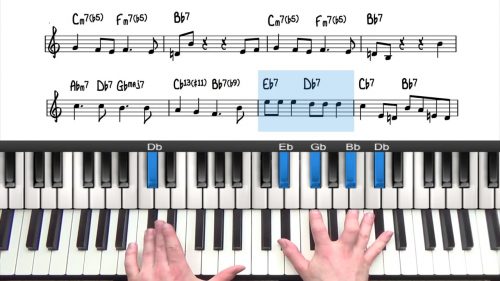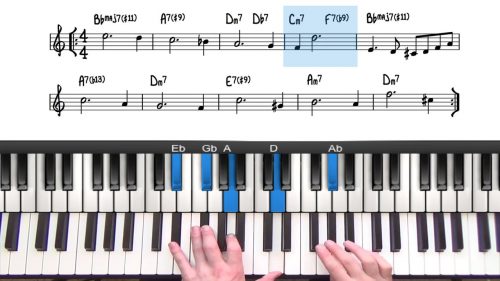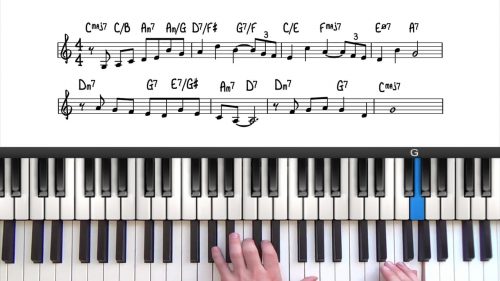Naima – Solo Piano Tutorial
In this lesson, we’re going to create a solo piano arrangement of John Coltrane song ‘Naima’.
Giant Steps Album
The song first appeared on the album Giant Steps, which I recommend to check out as it is one of the most influential albums of all time. Naima has also become one of the most known and played modal ballads.
The Form & Pedal Points
The tune follows an A A B A form. This song is a great example of the use of pedal point, where the chord color changes over the same bass note, A parts over Eb pedal sort of resolving to Abmaj, and B over Bb pedal. The outro is the only part that is around tonal center Ab. Let’s go through the tune.
Practice Tips
-
If you are new to slash chords, check out the related lesson above.
-
This song is a great example of the use of pedal point where the chord colour changes over the same bass note.
-
Be sure to check out the album "Giant Steps" to learn more about Coltrane's style.







ok, you’re killing me…i didn’t even know this was one of the lessons as I voted for this awhile ago. I’m in heaven and no longer care about the routines of my daily life until i learn this song completely! Thank you so much, Tuomo & Hayden, for doing this lesson. It’s absolutely beautiful. Also Tuomo gives a wonderful and concise understanding of modal so now i won’t beat my brain trying to figure out the functional harmony and just enjoy the chords. Thanks again.
Thank you Lonnie, I’m glad you liked the lesson! Stay tuned for more!
Hi Tuomo,
Wow what a great tutorial I really enjoyed this and it is one my favorite tunes that got me into jazz music years ago :).
I was a bit scared at the beginning to start the tutorial since it is flagged as advanced, but I am able to get satisfying results with your guidance playing this ! :).
Thank you.
Regards,
Ariel.
Thank you Ariel, I’m so happy you enjoyed the tutorial!
Let me know if I you have any questions,
All the best,
-Tuomo
Hi Tuomo, about a year ago I was convinced that I’ll never be able to understand, conceptually or practically, modal ballad playing.
After tackling this lesson, the basics of modal playing has become much clearer to me based on your very, very clear and instructive lesson.
Thank you, as always, greatly. Smole
Thank you so much for the kind words, happy I can help!
Also check out new fun transcription exercises on the forum,
pianogroove.com/community/c/improvisation-exercises/30
keep up the good work,
-Tuomo
Hi @Tuomo Thanks so much for this lesson. I approached it with some apprehension since I’m just beginning to explore modal jazz but I was pleased to be able to follow much better than I expected. I’m a bit confused as to how to to work out which modes tunes are in. Is it in the same mode all the way through? I think the A sections are in EbMyxolydian since it resolves to Ab but I might have pegged it for EbDorian because Gb occurs in the second chord. Is the B section still in the same mode or has the tonal centre changed to Bb?
Rather than get more confused i’m going out on the deck to listen to Coltrane’s rendition and any others I find. Amazingly it’s 22 degrees (72F) in Ontario right now and the sun is shining.
Hi George, thanks for writing!
Here my thoughts on modality:
When it comes to modality, you can basically forget tonal thinking (where everything is just II V Is, dominant resolving to a tonic).
In modality in general, every chord has it’s own sound, not necessarily related to the following chords in the song; think of it as a static chord sound/color moving to another different sound/color. Good example of a modal composition is ‘So What”, where we just have D dorian as A sections, and Eb dorian as a B section; just a scale sound that is defined by the notes of the mode, without any need to resolve.
In ‘Naima’, the mode is changing often; every time the chord changes. Bass notes Eb and Bb work as a “pedal”, where mode changes over the same bass note throughout a section. Of course, there is a small tonic element; the last bar of each section clearly sounds as a tonal resolution, as well as the outro.
See a mode chart as an attachment, where each mode is written out, and let me know if you have any further questions.
Also let me know if you’re not familiar with all the modes in the chart, I’m happy to explain them thoroughly!
thanks
-Tuomo
Thank you. That explains a lot. I didn’t realise each chord could generate its own mode (and mood) within a piece. I worked on “So What” some months ago. The whole piece is in Dorian mode throughout, whether D or Eb, Other modal tunes in my limited experience – like the theme for “the Simpsons” (Lydian) and “Game of Thrones” (Aolean) are also in one mode throughout. Naima threw me for a loop because it didn’t follow this pattern.
I’m beginning to see how hefty was the rule-book that Coltrane threw away!
Aye,
George
Glad to help!
-Tuomo
Hello,
At 8:24 you say that the Emaj7/Bb at the end of the B section is the same chord as from the third bar of the A part. I’ve wracked my brain and can it figure out what you mean by this. Could you please explain?
Thanks,
Rory
Hi Rory, glad to explain!
What I mean by Emaj7/Bb being the same chord as Amaj7/Eb, I’m pointing out the chord of course is not the exact same, but just the same chord transposed to a different place. Please see the attachment for better explanation.
The explanation of the A section’s bar no. 3 is on 5:18, if you want to revisit :)
Thanks, let me know if you have any further questions!
-Tuomo
Thank you! That is so helpful and makes perfect sense.
Best,
Rory
Rory, thanks, I’m glad I could help!
All the best,
-Tuomo